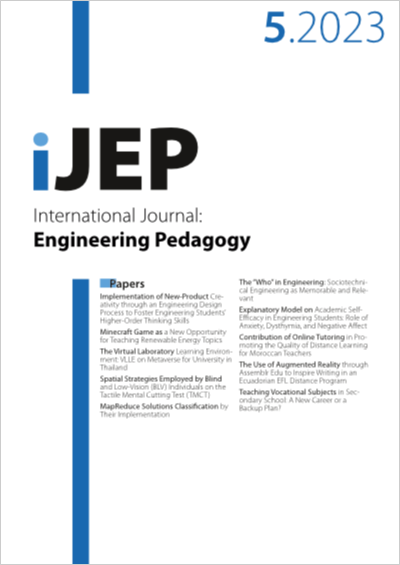Explanatory Model on Academic Self-Efficacy in Engineering Students: Role of Anxiety, Dysthymia, and Negative Affect
DOI:
https://doi.org/10.3991/ijep.v13i5.38577Keywords:
Self-Efficacy, Anxiety, Depression, Emotions, Structural Equation ModelAbstract
Students in engineering tend to be loners, making interpersonal relationships and mental health issues more likely to arise. The COVID pandemic caused university students to experience anxiety and depression, which affected their academic performance and self-esteem. However, students’ mental health was rarely evaluated after the pandemic, especially engineering students, who showed higher levels of depression than students from other disciplines. The present study aims to establish an explanatory model of academic self-efficacy based on factors related to mental health, such as anxiety, depression, and negative emotions. The method used was quantitative cross-sectional, and a structural equation modeling was used. A sample of 561 students (54.4% males and 45.6% females) was analyzed. Instruments to measure self-efficacy, negative affect, depression, and anxiety, previously validated and with adequate reliability, were applied. The results showed that a state of anxiety affects academic self-efficacy negatively and directly; depression and negative affect indirectly affect academic self-efficacy mediated by a state of anxiety. These results show that a student with depression problems and a predominance of negative emotions is vulnerable to present anxiety in an academic setting. This anxiety causes his efficacy beliefs to decrease. As a result, he does not feel capable of facing academic challenges.
Downloads
Published
How to Cite
Issue
Section
License
Copyright (c) 2023 Daniel E. Yupanqui-Lorenzo, Edith S. Olivera-Carhuaz, Antonio A. Reynaga Alponte, Víctor Pulido-Capurro, Carlos Carbajal-León, Manuel Antonio Cardoza Sernaqué

This work is licensed under a Creative Commons Attribution 4.0 International License.
The submitting author warrants that the submission is original and that she/he is the author of the submission together with the named co-authors; to the extend the submission incorporates text passages, figures, data or other material from the work of others, the submitting author has obtained any necessary permission.
Articles in this journal are published under the Creative Commons Attribution Licence (CC-BY What does this mean?). This is to get more legal certainty about what readers can do with published articles, and thus a wider dissemination and archiving, which in turn makes publishing with this journal more valuable for you, the authors.
By submitting an article the author grants to this journal the non-exclusive right to publish it. The author retains the copyright and the publishing rights for his article without any restrictions.
This journal has been awarded the SPARC Europe Seal for Open Access Journals (What's this?)


